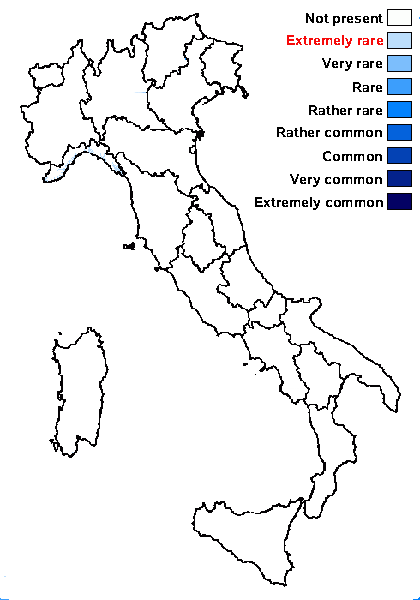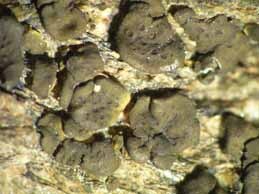Peltula rodriguesii (Cromb.) Büdel
Lichenologist, 21: 293, 1989. Basionym: Heppia rodriguesii Cromb. - J. Linn. Soc. Bot., 15: 436, 1876.
Synonyms:
Distribution: N - Lig.
Description: Thallus squamulose, consisting of up 2 mm wide, 250-300 µm thick, flat to convex, olive-yellowish to yellowish brown, 3-5 times lobed, peltate squamules with smooth margins. Upper cortex absent; epinecral layer 7-10 µm thick; medulla white, with numerous air spaces; lower cortex proso- to paraplectenchymatous, 20-25 µm thick, of more or less isodiametrical cells. Apothecia immersed in the squamules, at first punctiform, then expanded and to 0.3 mm across, with a reddish brown disc and a slightly raised thalline margin. Exciple poorly developed, to 8 µm thick; epithecium brownish; hymenium colourless, 180-250 µm high, I+ blue-green turning wine-red; paraphyses mostly simple, anastomosing, 1.5-2.5 µm thick, the apical cell slightly swollen; hypothecium colourless, 25-35 µm high. Asci >100-spored, clavate to obclavate, unitunicate-rostrate with a distinct, fringed external tunica, the wall I+ orange, K/I+ intensively blue. Ascospores 1-celled, hyaline, subglobose to broadly ellipsoid, 3-6 x 2-3.5 µm. Pycnidia immersed, cerebriform. Conidia fusiform, c. 1.5 x 0.5 µm. Photobiont cyanobacterial, chroococcoid, one-celled. Spot tests: K-, C-, KC-, P-. Chemistry: without lichen substances.Note: on basic siliceous rocks in the Mediterranean belt; the Italian record is the only one known from Europe.
Growth form: Crustose
Substrata: rocks
Photobiont: cyanobacteria, filamentous (e.g. Nostoc, Scytonema)
Reproductive strategy: mainly sexual
Subcontinental: restricted to areas with a dry-subcontinental climate (e.g. dry Alpine valleys, parts of Mediterranean Italy)
On otherwise dry surfaces with short periods of water seepage after rain
Commonnes-rarity: (info)
Alpine belt: absent
Subalpine belt: absent
Oromediterranean belt: absent
Montane belt: absent
Submediterranean belt: absent
Padanian area: absent
Humid submediterranean belt: absent
Humid mediterranean belt: extremely rare
Dry mediterranean belt: absent

Predictive model
Growth form: Crustose
Substrata: rocks
Photobiont: cyanobacteria, filamentous (e.g. Nostoc, Scytonema)
Reproductive strategy: mainly sexual
Subcontinental: restricted to areas with a dry-subcontinental climate (e.g. dry Alpine valleys, parts of Mediterranean Italy)
On otherwise dry surfaces with short periods of water seepage after rain
Commonnes-rarity: (info)
Alpine belt: absent
Subalpine belt: absent
Oromediterranean belt: absent
Montane belt: absent
Submediterranean belt: absent
Padanian area: absent
Humid submediterranean belt: absent
Humid mediterranean belt: extremely rare
Dry mediterranean belt: absent

Predictive model
 Index Fungorum
Index Fungorum
 GBIF
GBIF



